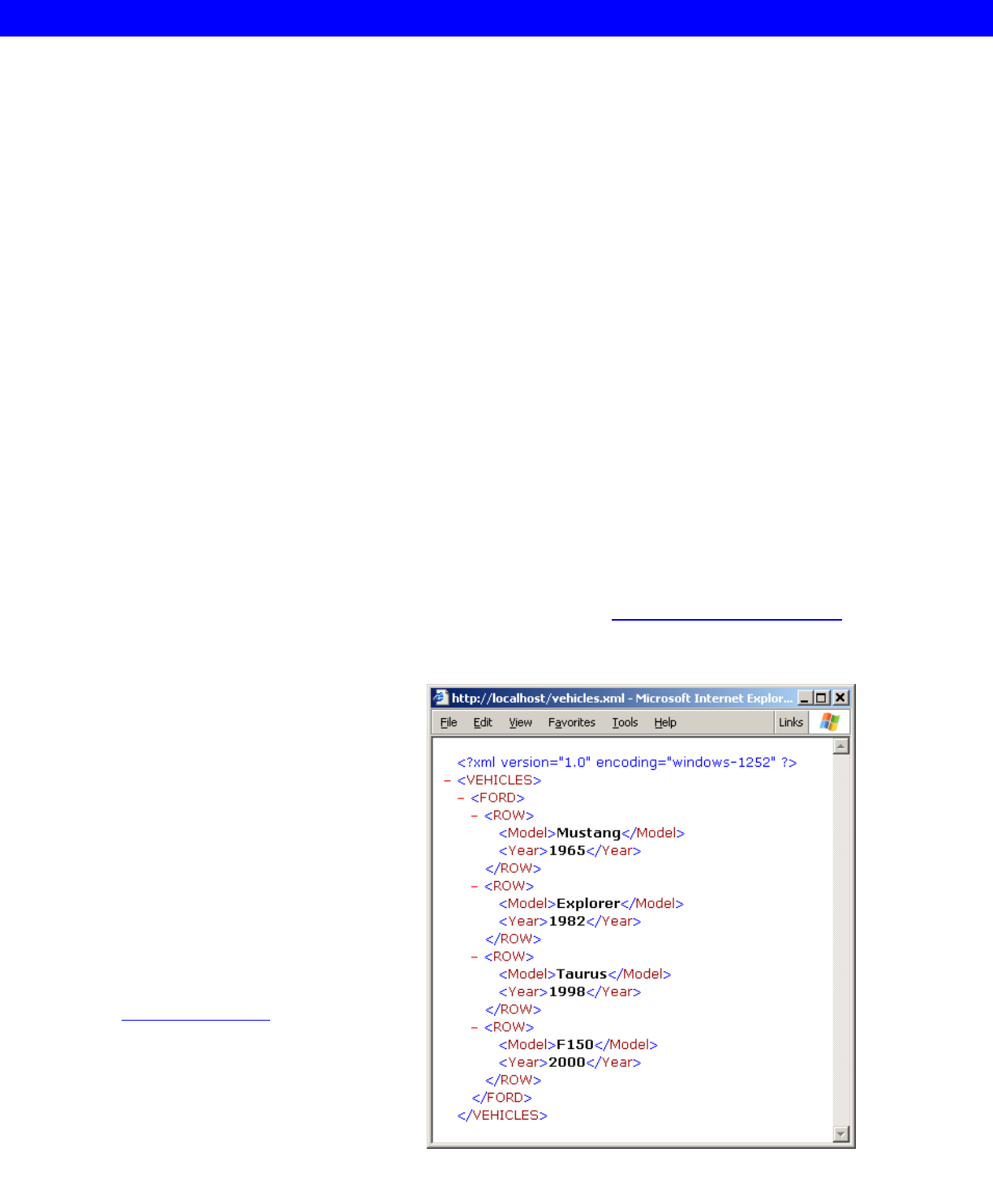
1
From SAS
®
to Excel via XML
Vincent DelGobbo, SAS Institute Inc., Cary, NC
ABSTRACT
Transferring data between SAS and Microsoft® Excel can be difficult, especially when SAS is not installed on a
Windows® platform. This paper discusses using new XML support in BASE SAS 9.1 software to move data between
SAS and Microsoft Excel (versions 2002 and later). You can use the techniques described here regardless of the
platform on which SAS software is installed, such as Windows, OpenVMS™, UNIX® or z/OS®. The use of SAS
server technology is also discussed.
INTRODUCTION
The techniques described in this paper are for people who either have not licensed SAS 9.1 SAS/ACCESS® to PC
Files, or those who want to display parts of SAS output in separate Excel worksheets.
Techniques currently exist for those in other situations:
• Using SAS 9.1 SAS/ACCESS® to PC Files, you can import Excel data into SAS and write to Excel
workbooks from both Windows and UNIX environments (Plemmons, 2003). In previous releases of SAS,
access to Excel was only possible with Windows versions of SAS software.
• If you want SAS output in a single Excel worksheet, you can use the Output Delivery System (ODS) to
generate an HTML file which you can then be opened with Excel (DelGobbo, 2003).
This paper and all source code are available on the SAS Presents Web site (http://support.sas.com/saspresents/
).
WHAT IS XML?
XML is an acronym for Extensible Markup
Language, and represents a way to define
and format data for easy exchange. XML
is similar to HTML in that it uses tags.
Unlike HTML, whose tags control how data
is rendered, XML tags describe the
structure and meaning of data but do not
control how it is rendered.
For example, consider the XML file shown
in Figure 1. The file contains the make,
model name, and model year for several
vehicles. Note the lack of HTML tags such
as <TABLE>, <TR>, and <TD>. Instead,
well-structured XML tags are used to
describe the data. To find out more about
XML, refer to the World Wide Web
Consortium® Web site
(http://www.w3.org/XML
).
XML SUPPORT IN SAS 9.1
Support for XML in BASE SAS 9.1 is better
than in any prior release. The two SAS
XML tools of interest here are the SAS
XML LIBNAME engine and the ExcelXP
ODS tagset.
Figure 1. Sample XML file.
Ins & OutsNESUG 17
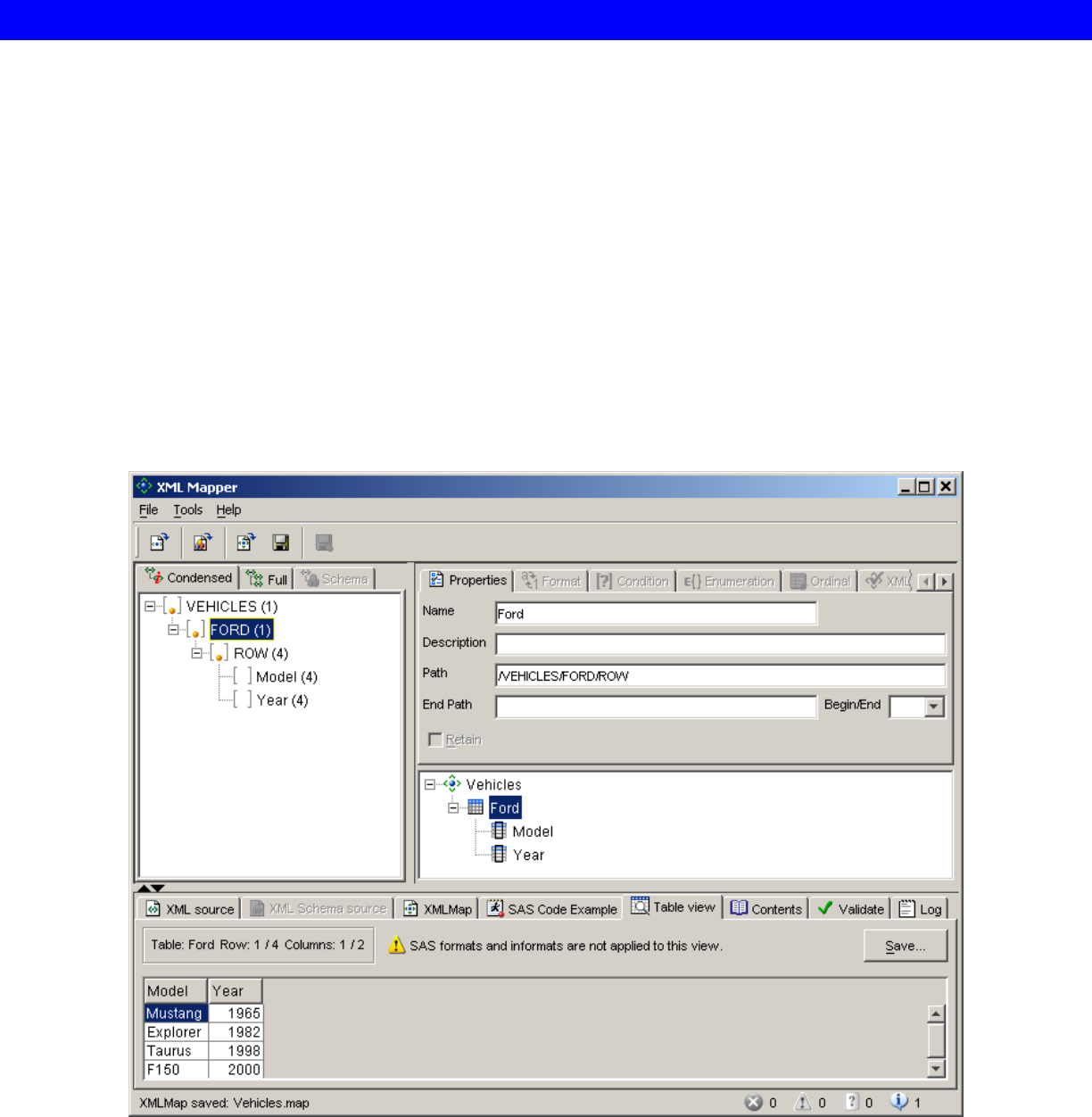
2
THE SAS XML LIBNAME ENGINE (SXLE)
The SAS XML LIBNAME Engine can import an XML file into a SAS table or export a SAS table as an XML file. Thus,
you can use the SXLE to exchange data between SAS and third-party, XML-aware applications such as Excel.
While the SXLE has been available since SAS release 8.1, recent improvements have made it possible to precisely
control how data is imported. The new SAS XMLMap enables you to map any XML element or attribute to a column
or row in a SAS table. The SXLE then uses the XMLMap to control how the XML data is imported into a SAS table.
You can manually create the XMLMap using a text editor (this is not recommended), or you can use the new XML
Mapper (formerly know as XML Atlas) which provides a point-and-click interface.
USING THE XML MAPPER
To briefly illustrate the use of the XML Mapper, consider the XML shown in Figure 1. From this XML we want to
create a SAS table named Ford that has two columns, one named Model and the other Year. Figure 2 shows the
XML Mapper after the mapping has been performed.
Figure 2. Building a simple SAS XMLMap with the XML Mapper.
In the upper left, the Condensed tab displays the structure of the XML data that you want to import. On the right, the
XMLMap pane contains fields and a tree view of the XMLMap. The bottom pane shows the rows and columns of the
SAS table that are a result of the mapping.
Ins & OutsNESUG 17

3
To create and use the XMLMap shown in Figure 2, follow these steps:
1. Open the Vehicles.xml file.
2. Click on VEHICLES in the Condensed tab and drag it onto the Name field of the XMLMap pane.
VEHICLES will appear in the Name field. Change the name to Vehicles. A node named Vehicles appears in
the XMLMap tree.
3. In the Condensed tab, click on ROW and drag it onto the node named Vehicles in the XMLMap tree. You
will now have a node named ROW under the Vehicles node. Click on the ROW node and change the name
to Ford.
4. In the Condensed tab, click on Model and drag it onto the Ford node in the XMLMap tree.
5. In the Condensed tab, click on Year and drag it onto the Ford node in the XMLMap tree.
6. Save the XMLMap file by selecting File ➨ Save XMLMap As. Name the XMLMap file Vehicles. This creates
a file named Vehicles.map.
7. Access the Vehicles.xml file as a SAS table by submitting the following SAS statements, supplying any
necessary path information on the FILENAME statements:
filename MYMAP 'Vehicles.map'; * created and saved by XML Mapper;
filename MYXML 'Vehicles.xml'; * raw XML file to import;
libname MYXML xml xmlmap=MYMAP access=readonly;
You can now access the Vehicles.xml file as a SAS table, via the MYXML LIBREF:
proc print data=myxml.Ford; run; quit;
Details about how to import Excel workbooks into SAS tables are covered in the “Moving Excel Data to SAS” section
of this paper.
THE EXCELXP ODS TAGSET
An ODS tagset is a template that controls the type of tags (markup) applied to SAS output. For example, an HTML-
based tagset would embed HTML tags in SAS output. There are over 50 tagsets shipped with BASE SAS 9. To see
a full listing of the tagsets available on your system, use the TEMPLATE procedure as follows:
ods listing;
proc template; list tagsets; run; quit;
Once you determine which tagset you want to use, specify the name of the tagset in the ODS statement, for example:
ods tagsets.TagsetName file=... ;
* your SAS code here;
ods tagsets.TagsetName close;
In SAS 9, the MSOffice2K tagset generates HTML that can be imported by Microsoft Excel and Microsoft Word,
versions 2000 and later (DelGobbo, 2003).
In contrast, the SAS 9 ExcelXP tagset generates XML, and can be used with Microsoft Excel 2002 (also known as
Excel XP). To use the ExcelXP tagset, simply use the ExcelXP tagset name in an ODS statement, as illustrated
above, and open the resulting XML file with Excel. The main benefit of using the ExcelXP tagset and not the
MSOffice2K tagset is that each table of the SAS output is placed into a separate worksheet within the workbook.
However, there are some current disadvantages to using the ExcelXP tagset that you should be aware of:
• The tagset is experimental. This means that limited testing has been performed on it, and its functionality
may change in the future.
• The tagset has not yet been optimized. It may take an unexpectedly long time to generate an XML file.
This problem has been fixed in SAS 9.1.3.
• You cannot use graphics in your SAS XML output because Excel does not support embedded graphics in
an XML file.
Significant enhancements have been made to the ExcelXP tagset since the release of SAS 9.1. You can download a
recent version of the ExcelXP tagset as well as the source code for this paper from the SAS Presents Web site
Ins & OutsNESUG 17
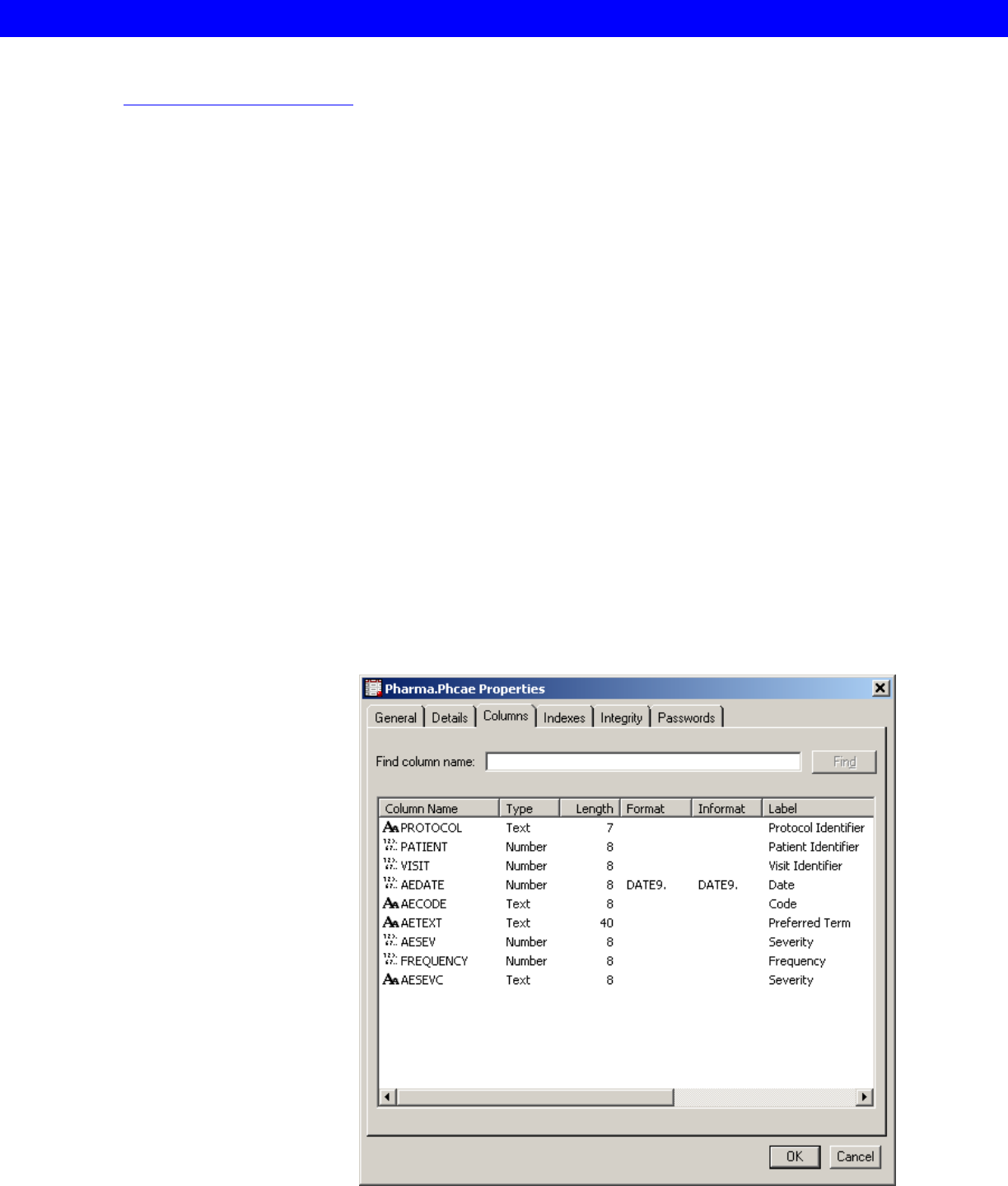
4
Figure 3. Columns in the SAS adverse event table.
(http://support.sas.com/saspresents). The download contains a file named "excelxp.sas", which contains the SAS
code needed to create the ExcelXP tagset. Save a copy of this file and submit this SAS code to make the tagset
available:
n libname myLib 'directory-for-tagset'; * location to store the tagset;
o ods path myLib.tmplmst(update) sashelp.tmplmst(read);
%include 'excelxp.sas';
The LIBNAME statement at n specifies where to store the tagset. Although you can use the WORK library to
temporarily store the tagset, a more efficient process would be to create the tagset one time and store it in a
permanent library so that you can reference it in other SAS programs.
The ODS PATH statement at o specifies the locations and the order in which ODS searches when looking for tagsets
and styles. Note that the access mode for the location "myLib.tmplmst" is specified as "update", while
"sashelp.tmplmst" is specified as "read". Because ODS searches the PATH in the order given, and because
myLib.tmplmst has an “update” access mode, PROC TEMPLATE will store the tagset in a file named
"tmplmst.sas7bitm" in the directory associated with the MYLIB library.
Details about how to use the ExcelXP tagset are covered in the "Moving SAS Data to Excel" section of this paper.
XML SUPPORT IN EXCEL 2002
Excel 2002 supports importing XML documents as well as saving workbooks as XML files. To save a workbook in
XML format, select File ➨ Save As, and then choose the "XML Spreadsheet" format. Your entire workbook is saved
as a single XML file, which can then be imported into one or more SAS tables (each worksheet is imported into a
separate SAS table).
XML files that conform to the Microsoft XML Spreadsheet Specification can be opened by Excel. The ODS ExcelXP
tagset creates such XML. Thus, to import your SAS output that was generated using the ODS ExcelXP tagset into
Excel, just open the XML file
with Excel.
As mentioned earlier, Excel
does not support graphics in
XML files.
MOVING SAS DATA TO
EXCEL
This section guides you through
the process of moving SAS data
to Excel: generating the XML
output, opening the output in
Excel, and then correcting the
format of the data.
Figure 3 shows the column
properties of the data that we
are going to move to Excel. The
data is adverse event data for a
fictitious drug.
Note that labels have been
applied to each column in the
table. This allows for a more
attractive table when imported
into Excel.
Ins & OutsNESUG 17
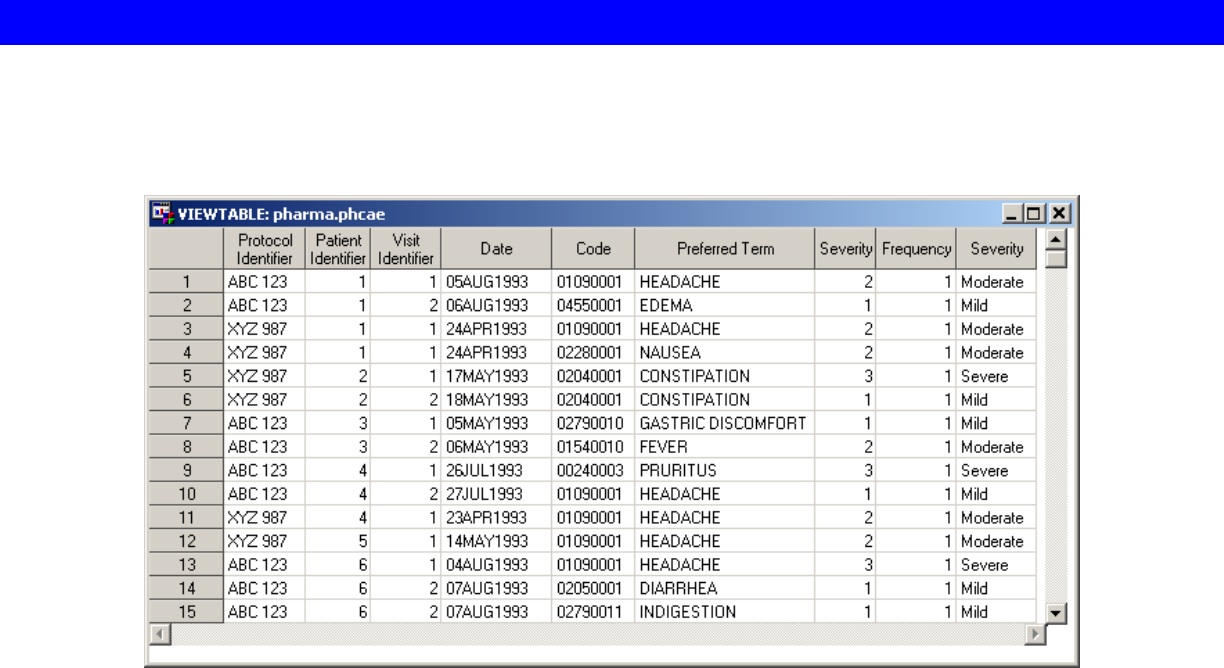
5
The two columns AESEV and AESEVC represent the severity of the adverse event. As illustrated in Figure 4, the
same data is represented two ways: AESEV contains a numeric value for the severity while AESEVC contains a
character value. The SAS code later in this example makes use of both columns.
Figure 4. Partial view of the SAS adverse event table.
Notice that the Code column contains values that have leading zeroes. By using an ODS style override you can
retain the leading zeros when importing the data into Excel.
GENERATING THE XML FILE
The following SAS code demonstrates the general technique needed to create an XML file that can be opened with
Excel:
n ods listing close;
o ods tagsets.ExcelXP file="phdata.xml" path="path-to-output" style=Statistical;
* your SAS code here;
p ods tagsets.ExcelXP close;
The ODS statement at n turns off the standard "line printer" ODS destination. We are only concerned with
generating XML output.
The ODS statement at o generates the XML output and stores it in a file named "phdata.xml". The STYLE attribute
controls the output color scheme, and in this case is set to the Statistical style, which is new for 9. To see a list of
ODS styles that are available for use at your installation, submit the following SAS code:
ods listing;
proc template; list styles; run; quit;
The ODS statement at p closes and releases the XML file so that it can be opened with Excel.
Complete SAS code that executes the PRINT and TABULATE procedures and generates an XML file can be found in
the Appendix of this paper in the section "Original Code to Export SAS Output to Excel as XML".
OPENING THE XML FILE WITH EXCEL
To open the ODS-generated phdata.xml file with Excel, just select it using File ➨ Open.
Ins & OutsNESUG 17
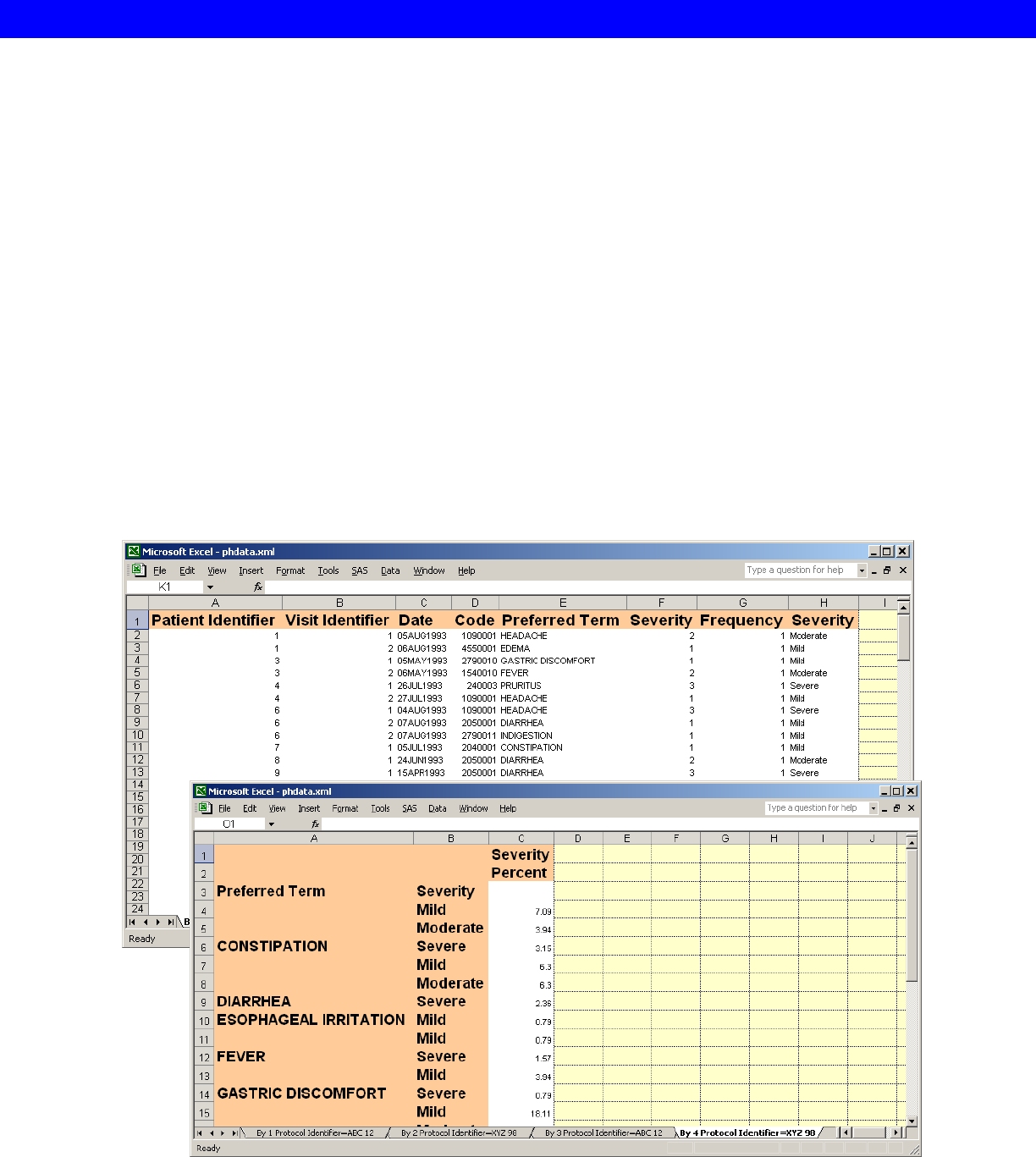
6
Figure 5 (below) shows the XML file opened in Excel. The workbook consists of 4 worksheets. The two worksheets
in the foreground are output from the TABULATE procedure. The two worksheets in the background are the result of
the PRINT procedure. Each time ODS generates a new table, it is written to a new worksheet.
CORRECTING FORMATTING PROBLEMS
Although Excel does a fairly good job of formatting the phdata.xml file, there are still a few problems you should
correct. Unfortunately, because Excel does not automatically resize text-based columns when reading an XML file,
when you first open the XML file most of the columns are not wide enough to show all the data or headings. A future
release of the ExcelXP tagset may correct this problem.
First, notice that the leading zeroes were dropped from the Code column. This is due to Excel applying the General
format to the Code column data. By using an ODS style override and applying the Excel format 00000000 to the
column (similar to the SAS Z8. format), we can instruct Excel to retain the leading zeroes (DelGobbo, 2003). Use the
following PROC PRINT code to instruct Excel to use the 00000000 format, instead of the General format:
proc print data=pharma.phcae noobs label;
by protocol;
var patient visit aedate;
var aecode / style={tagattr="\00000000"};
var aetext aesev frequency aesevc;
run; quit;
Figure 5. ODS XML output viewed with Microsoft Excel, after manually resizing columns.
Ins & OutsNESUG 17

7
The other problem to correct is that of the missing cell border lines (the Statistical style has no definition of border
lines for header and data cells). Although you can correct this problem using an ODS style override as we did with
the leading zero format problem, a more efficient solution is to create a new style that is tailored to Excel. The
following code uses the TEMPLATE procedure to create a new style that adds border lines to the Statistical style:
n libname myLib 'directory-for-style'; * location to store the style;
o ods path myLib.tmplmst(update) sashelp.tmplmst(read);
*;
* Apply cell borders to header and data cells.
* 1=None, 2=Thin, 3=Medium, 4=Thick
*;
p proc template;
define style XLStatistical;
parent = styles.Statistical;
replace Header from HeadersAndFooters /
borderwidth=2;
replace RowHeader from Header /
borderwidth=2;
replace Data from Cell /
font = fonts('docFont')
background = colors('databg')
foreground = colors('datafg')
borderwidth=2;
end;
run; quit;
The LIBNAME statement at n specifies where to store the new style. Although you can use the WORK library to
temporarily store the style, a more efficient process would be to create the style one time and store it in a permanent
library so that you can reference it in other SAS programs.
The ODS PATH statement at o specifies the locations and the order in which ODS searches when looking for tagsets
and styles. Note that the access mode for the location "myLib.tmplmst" is specified as "update", while
"sashelp.tmplmst" is specified as "read". Because ODS searches the PATH in the order given, and because
myLib.tmplmst has an “update” access mode, PROC TEMPLATE will store the style in a file named
"tmplmst.sas7bitm" in the directory associated with the MYLIB library.
The TEMPLATE procedure code at p creates the new style, named "XLStatistical". This style is based on the built-in
"Statistical" style that was used to generate the output in Figure 5. The new style sets the border width to 2 for
header and data cells, and adjusts font and color specifications for data cells. Details on how to use the TEMPLATE
procedure to create and change styles can be found in chapter 5 of the ODS documentation (SAS Institute Inc.,
1999).
To use the new style in future SAS code, supply an ODS PATH statement and then reference the style by its name.
For example, the following code is a modified version of the code used to generate the output in Figure 5:
libname myLib 'directory-for-style-and-tagset' access=read;
ods path myLib.tmplmst(read) sashelp.tmplmst(read);
ods listing close;
ods tagsets.ExcelXP file="phdata.xml" path="path-to-output" style=XLStatistical;
* your SAS code here;
ods tagsets.ExcelXP close;
Ins & OutsNESUG 17

8
Figure 6 shows the corrected formats of the XML file as viewed in Excel. All of the table cells have border lines, and
the Code column retains the leading zeroes. The complete SAS code to create this XML can be found in the
Appendix of this paper in the section "Corrected Code to Export SAS Output to Excel as XML ".
Figure 6. Corrected ODS XML output viewed with Microsoft Excel, after manually resizing columns.
MOVING EXCEL DATA TO SAS
Figure 7 (below) shows the Excel workbook we want to import into SAS. The workbook contains 4 worksheets. We
want to import the data from each worksheet into a different SAS table, using the name of the worksheet for the table
name. The sections that follow explain how to save the workbook as an XML file, and then how to load the workbook
into SAS using a provided SAS macro and SAS XMLMap, both designed specifically for Excel XML data. All the
necessary SAS code is supplied for you.
SAVING AN EXCEL WORKBOOK AS XML
You must save an Excel workbook as an XML file before you can import it into SAS. To do so, in Excel select
File ➨ Save As, and choose "XML Spreadsheet". Specify a name and directory for the file. For the purpose of this
paper, we saved the XML in a file named "mydata.xml".
Ins & OutsNESUG 17
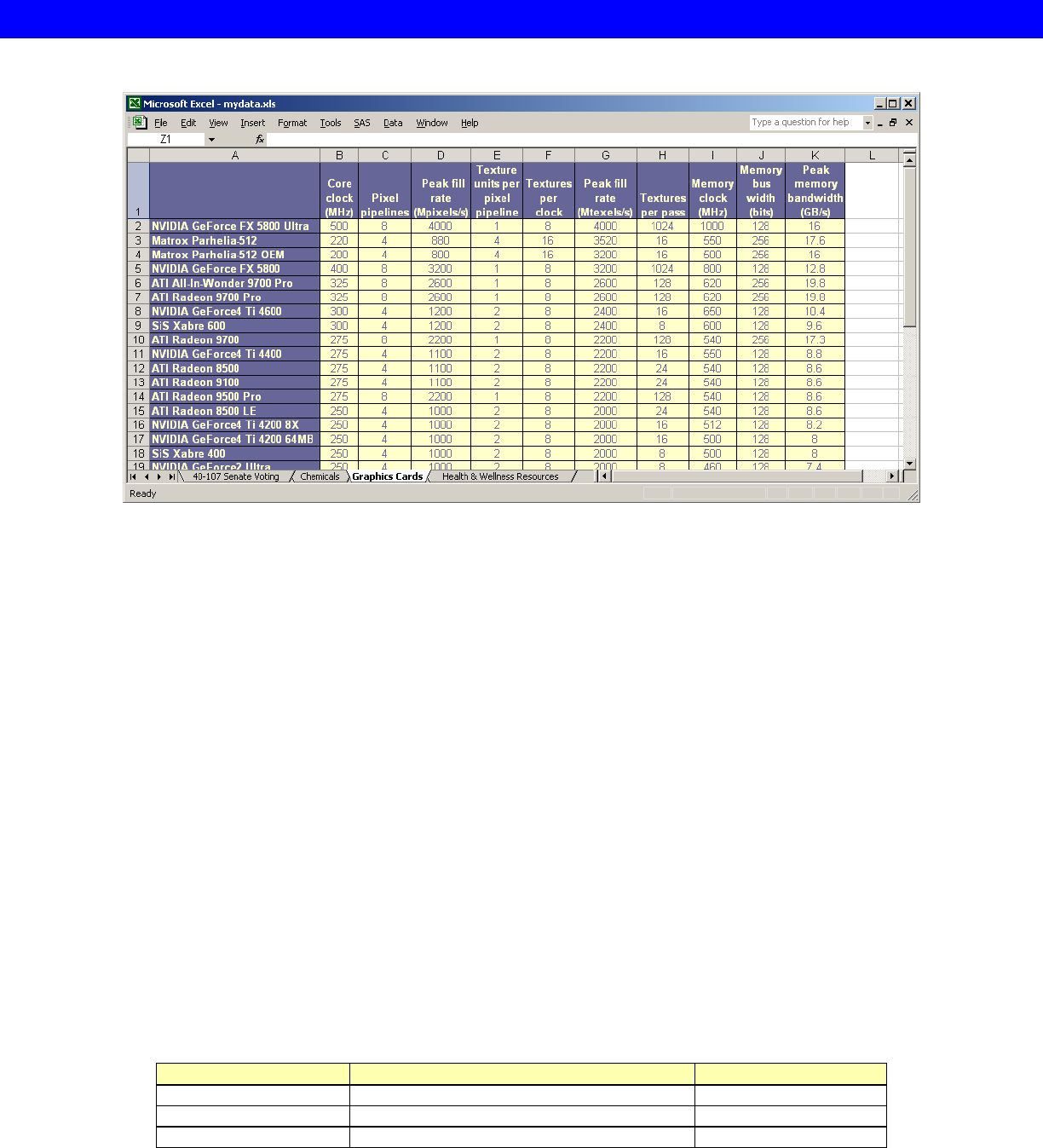
9
Figure 7. Excel workbook with data to import into SAS.
To ensure that SAS can access the mydata.xml file, you can save the file on a network-accessible drive. Then you
can access the file as if it were native to the operating system where SAS is installed. Another solution is to save the
file to a location that is under the control of a Web server. SAS will then be able to read the file using the URL access
method, which is part of BASE SAS. These techniques are useful if SAS is installed on a different machine from
Excel. If neither of these options is available to you, move the file from the Windows machine to the machine that has
SAS installed using FTP or some other method.
If you place the files where others can access them, be sure to set file permissions to prevent accidental alteration.
AUTOMATIC DATA CONVERSION BETWEEN EXCEL AND SAS
You need to be aware of some of the behaviors to expect when converting Excel data to SAS data. As mentioned
earlier, when the worksheet in Figure 7 is imported into a SAS table, the name of the worksheet, "Chemicals" (for
example) is used as the SAS table name. However, the technique of using the worksheet name for the table name
does not always work. For example, a worksheet named "40-107 Senate Voting" cannot be used for the SAS table
name because it begins with a number and contains invalid characters (the spaces and a dash). Therefore, the
provided SAS code that loads the worksheet into SAS must convert the "4" and other invalid characters to an
underscore ("_"). In this case the resulting SAS table name would be "_0_107_Senate Voting". Likewise, importing a
worksheet named "Health & Wellness Resources" would result in a table named "Health___wellness_resources".
Attempting to use Excel column labels for SAS table column names can result in a similar problem. Note that none of
the column labels in Figure 7 can be used as SAS column names because they all contain invalid characters such as
blanks, parentheses and the forward slash ("/"). Additionally, the first column does not have a label. The SAS code
that loads the worksheet into SAS must create valid column names by converting invalid characters to an underscore
("_"). SAS column labels are set to the original value of the Excel label. The table below shows examples of how
some of the Excel column labels in Figure 7 will be converted to SAS column names.
Excel Column Label SAS Column Name SAS Column Label
(blank) A unique 32-character name starting with "_" .
Pixel pipelines Pixel_pipelines Pixel pipelines
Peak fill rate (Mpixels/s) Peak_fill_rate__Mpixels_s_ Peak fill rate (Mpixels/s)
Table 1. Conversion of Excel column labels to SAS column names.
Ins & OutsNESUG 17
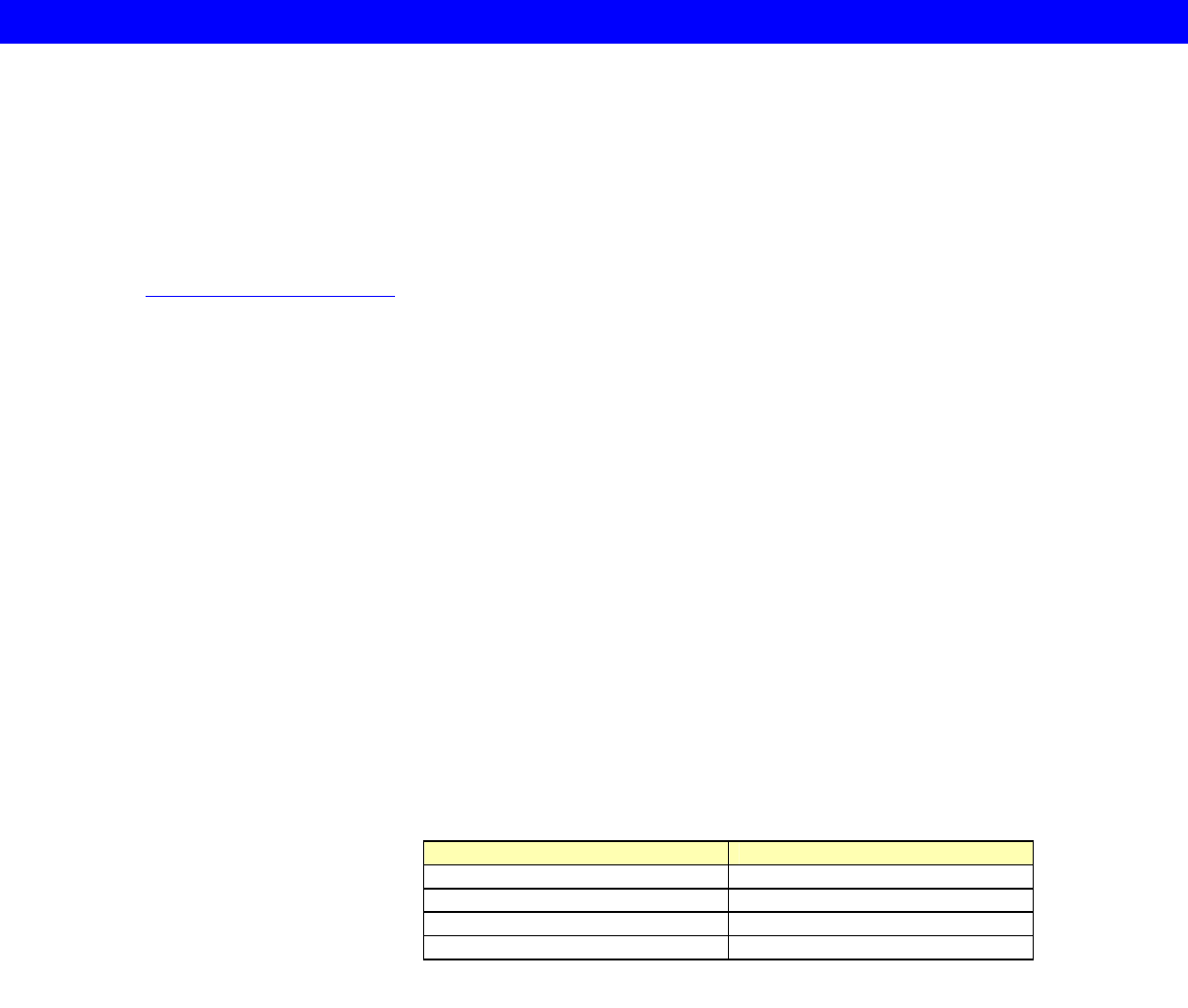
10
SAS Table Name SAS Label
Chemicals Chemicals
Graphics_cards Graphics Cards
Health___wellness_resources Health & Wellness Resources
_0_107_senate_voting 40-107 Senate Voting
Table 2.
S
AS tables created from Excel
workbook.
READING EXCEL XML INTO SAS
You could use the SXLE and an XMLMap of your own creation to import an Excel XML file into SAS, but because the
Excel XML format and the data conversion issues are quite complex, SAS provides an XMLMap specific to Excel and
corresponding SAS code that loads the Excel XML into SAS tables. As mentioned earlier, both components as well
as a SAS macro to import the XML data, are available for download from the SAS Presents Web site. These
components may ship with future releases of SAS, so watch the Base SAS Community Web site for further details
(http://support.sas.com/rnd/base/
)
Download the XMLMap and the SAS macro and make the two files available on the platform where SAS is installed.
This paper assumes that you saved the SAS XMLMap in a file named "excelxp.map" and the SAS macro to load the
XML data was stored in a file named "loadxl.sas". The file "loadxl.sas" contains a SAS macro named XLXP2SAS,
which is used to import the XML file into SAS tables.
The easiest way to explain how to use the macro is with a few examples. First, we will consider importing the XML
workbook shown in Figure 7 when either SAS is installed on the same machine that has the XML file or SAS is
installed on a different machine or platform, but the XML file is accessible via a network drive. To import the
workbook into SAS, submit this code, making sure to include the appropriate directory paths:
n %include 'loadxl.sas';
o %xlxp2sas(excelfile=mydata.xml,
mapfile=excelxp.map);
The statement at n makes the XLXP2SAS macro available to SAS. The statement at o imports the data from all the
worksheets into separate SAS tables. By default the SAS tables are created in the WORK library. You can control
the library used to store the SAS tables by specifying the LIBRARY argument of the XLXP2SAS macro. For example,
to store the tables in the SASUSER library, submit this code:
%xlxp2sas(excelfile=mydata.xml,
mapfile=excelxp.map,
library=sasuser);
Table 2 lists the SAS tables
created as a result of importing
the Excel workbook shown in
Figure 7. Note that while the
table names may look a bit odd,
the actual worksheet names are
used in the SAS labels.
Figure 8 (below) shows a portion of the "Graphics_cards" table. By comparing Figures 7 and 8, you can see that the
XLXP2SAS macro successfully imported the "Graphics Cards" worksheet as a SAS table. For instance, the columns
"Pixel pipelines" and "Memory bus width (bits)" were both correctly typed as character, because those columns
contain data such as "2*2" and "128*2", respectively.
Up to this point the assumption is that the XML file resides on the same machine as SAS or it was available via a
network accessible drive. However, if the XML file resides on the Web server of a remote machine, you can use the
URL access method to retrieve the file by submitting the following code:
filename myxml URL 'http://Web-server/mydata.xml';
%xlxp2sas(excelfile=FILEREF:myxml,
mapfile=excelxp.map);
Ins & OutsNESUG 17
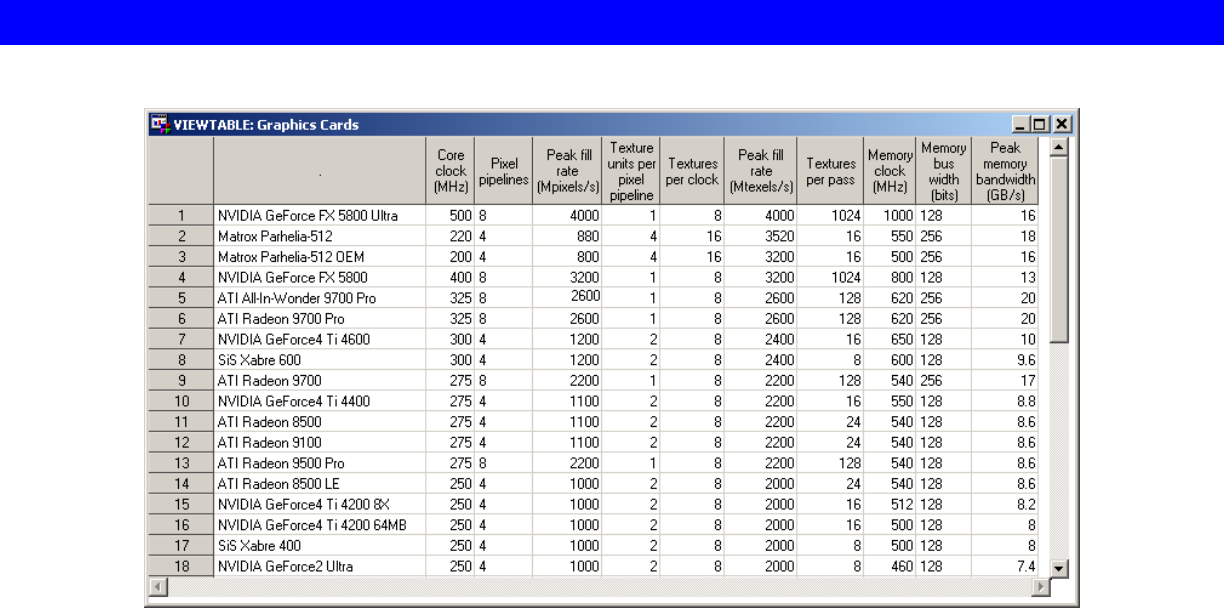
11
Figure 8. SAS Graphics_cards table, created by importing an Excel workbook.
The submitted code causes XLXP2SAS to contact the Web server to retrieve the XML file, rather than looking for it on
a local disk. The FILEREF modifier can also be used with the MAPFILE argument to retrieve the SAS XMLMap from
a Web server.
Documentation for the XLXP2SAS macro can found in the Appendix of this paper in the section "XLXP2SAS Macro
Documentation".
XLXP2SAS DRAWBACKS AND LIMITATIONS
There are a few issues surrounding XLXP2SAS that you should be aware of.
1. XLXP2SAS creates temporary tables in the WORK library. These tables can get very large. However, this
is generally not a problem unless your system is very low in disk space, as the temporary files are
automatically cleaned up after XLXP2SAS runs (unless the argument CLEANUP=N was specified).
2. The data in every worksheet you want to import must be fairly rectangular. Although the XLXP2SAS macro
attempts to handle non-rectangular data by adding missing values, the results can be unpredictable if the
data is too sparse.
3. By default, XLXP2SAS runs with the argument HASLABELS=Y. This implies that all worksheets in a
workbook have column labels in the first row. If none of your worksheets contain column labels in the first
row, specify HASLABELS=N when you invoke XLXP2SAS. The HASLABELS argument applies to all
worksheets in a workbook.
4. If you specify HASLABELS=N, the column names in the SAS table(s) will be of the form "COLUMN1",
"COLUMN2", "COLUMN3" and so on, and the respective column labels will be "Column 1", "Column 2" and
"Column 3".
USING SAS SERVER TECHNOLOGY TO BRING SAS OUTPUT INTO EXCEL
If you have licensed SAS/IntrNet® software, you can dynamically incorporate SAS output into Excel using the
Application Dispatcher. You can perform similar tasks with the Stored Process Server, which is new for SAS 9.1.
The Application Dispatcher and the Stored Process Server enable you to execute SAS programs from a Web browser
or any other client that can open an HTTP connection to either of these SAS servers (which can run on any platform
where SAS is licensed). The SAS programs that you execute from the browser can consist of any combination of
DATA step, PROC, MACRO, or SCL code. Thus, all of the code shown up to this point can be executed using either
Application Dispatcher or the Stored Process Server.
Ins & OutsNESUG 17

12
Program execution is typically initiated by accessing a URL that points to the SAS server program. Parameters are
passed to the program as name/value pairs in the URL. The SAS server takes these name/value pairs and
constructs SAS MACRO variables that are available to the SAS program.
For an example, the PRINT and TABULATE procedure code we have been using can be modified to use a WHERE
clause instead of BY-group processing by replacing the two existing BY statements with the following statement:
where &WHERE_CLAUSE;
A user can now specify any valid WHERE clause on the URL, and that WHERE clause will be used by your SAS
code. The code is executed on the SAS server via a URL such as:
http://path-to-server?_program=program-name&where_clause=aesev eq 3
Because of the changes to the code, the value specified in the URL for the parameter named WHERE_CLAUSE is
used by the PRINT and TABULATE code.
To dynamically create SAS output and place it into an Excel workbook, type the URL into the Open dialog box of
Excel. If you want to run your SAS code from a Web browser and have the output automatically included in Excel,
use the APPSRV_HEADER function to set the Content-type header for the XML file, as illustrated in the sample code
below:
%let rc = %sysfunc(appsrv_header(Content-type, application/vnd.ms-excel));
ods listing close;
ods tagsets.ExcelXP file=_WEBOUT …;
* your SAS code here;
ods tagsets.ExcelXP close;
When the code above is executed from a Web browser, Excel will start and the XML content generated by ODS will
be output to a new workbook.
These are just two samples of how you can take advantage of SAS server technologies. For details about the
operation of the Application Dispatcher or the Stored Process Server, refer to the respective documentation for those
servers.
CONCLUSION
SAS 9.1 enhances support for XML. ODS provides an easy way to export your data to Excel workbooks that contain
multiple worksheets. While it may be a bit cumbersome to use the SXLE and XMLMaps to import Excel data to SAS,
the use of the XLXP2SAS macro greatly simplifies the task.
SAS Institute continues to work toward better Microsoft Office integration, and future releases of SAS software will
provide even more robust means of using SAS content with Office applications.
APPENDIX
ORIGINAL CODE TO EXPORT SAS OUTPUT TO EXCEL AS XML
ods listing close;
ods tagsets.ExcelXP file="phdata.xml" path="directory-for-XML" style=Statistical;
proc print data=pharma.phcae noobs label;
by protocol;
var patient visit aedate aecode aetext aesev frequency aesevc;
run; quit;
proc tabulate data=pharma.phcae;
by protocol;
var aesev;
class aetext aesevc;
Ins & OutsNESUG 17
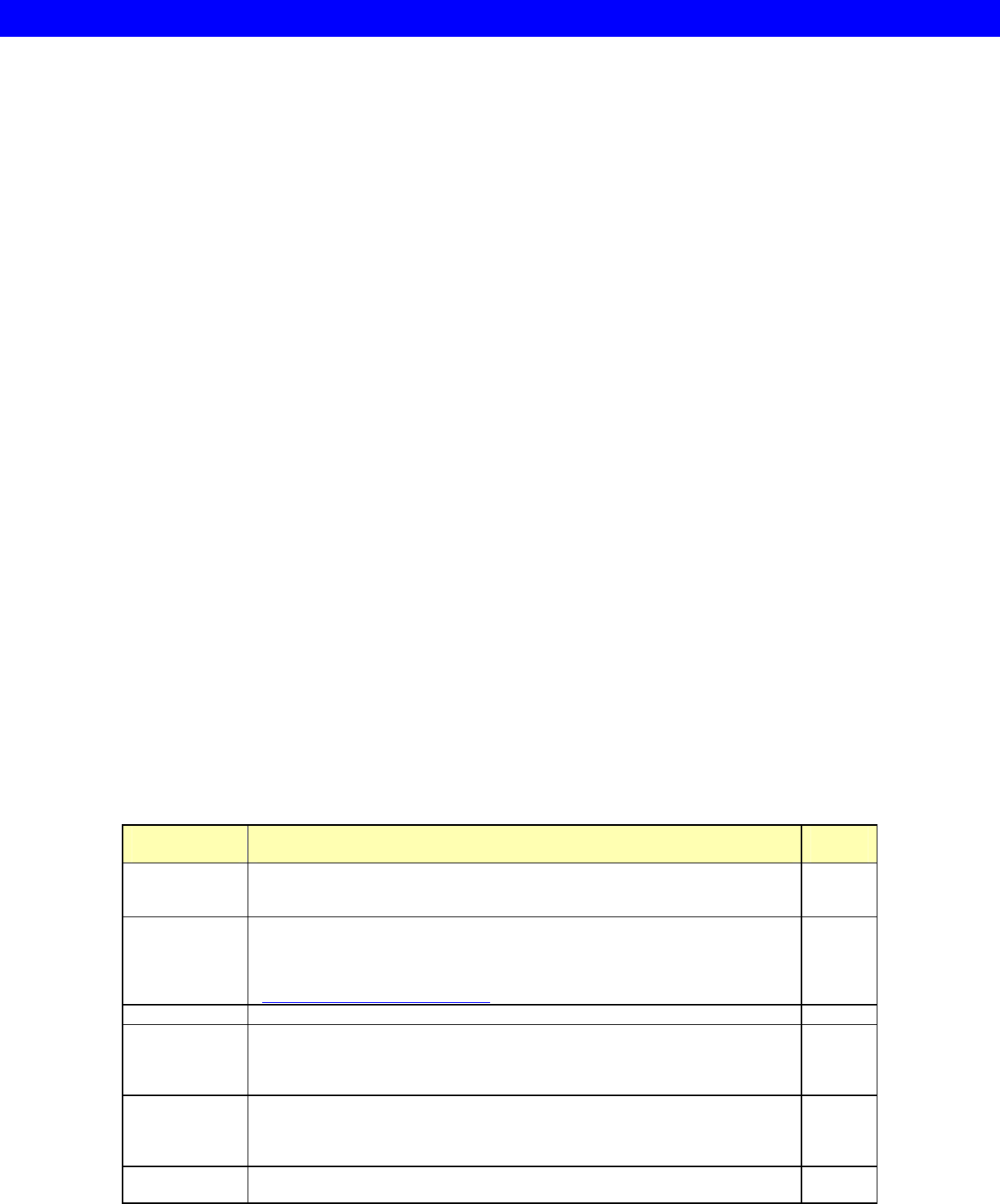
13
classlev aetext aesevc;
table aetext*aesevc,aesev*pctn;
keyword all pctn;
keylabel pctn='Percent';
run; quit;
ods tagsets.ExcelXP close;
CORRECTED CODE TO EXPORT SAS OUTPUT TO EXCEL AS XML
libname myLib 'directory-for-style' access=read; * location where style is stored;
ods path myLib.tmplmst(read) sashelp.tmplmst(read);
ods listing close;
ods tagsets.ExcelXP file="phdata.xml" path="directory-for-XML" style=XLStatistical;
proc print data=pharma.phcae noobs label;
by protocol;
var patient visit aedate;
var aecode / style={tagattr="\00000000"};
var aetext aesev frequency aesevc;
run; quit;
proc tabulate data=pharma.phcae;
by protocol;
var aesev;
class aetext aesevc;
classlev aetext aesevc;
table aetext*aesevc,aesev*pctn;
keyword all pctn;
keylabel pctn='Percent';
run; quit;
ods tagsets.ExcelXP close;
XLXP2SAS MACRO DOCUMENTATION
Below is a list of the arguments supported by the XLXP2SAS macro. All arguments require a value, except where a
default value is indicated.
Argument
Description
Default
Value
EXCELFILE The name and path for the Excel XML file you want to import to SAS. Do not use
quotes in this value. To specify a SAS FILEREF instead of a file, use
FILEREF:fref, where fref is the FILEREF.
MAPFILE The name and path of the SAS XMLMap for reading Excel XML files. Do not use
quotes in this value. To specify a SAS FILEREF instead of a file, use
FILEREF:fref, where fref is the FILEREF. You can download a copy of the SAS-
provided XMLMap from the SAS Presents Web site
(http://support.sas.com/saspresents
)
LIBRARY The name of the SAS library where imported tables are stored. WORK
HASLABELS Controls whether or not the worksheets have column labels in the first row of the
Excel table. This setting applies to all worksheets in a workbook. If set to Y, the
labels will be used for the SAS column names and labels. If your workbook does
not have column labels in the first row of the Excel table, specify N.
Y
CLEANUP Controls whether or not to delete temporary SAS files and also whether or not to
deassign FILEREFs that were used when importing the Excel data to SAS.
FILEREFS that you explicitly assign with a FILEREF statement will not be
deassigned. To disable this feature, specify N.
Y
VERBOSE Controls the level of debugging information written to the SAS LOG. Specify Y to
activate this feature.
N
Ins & OutsNESUG 17

14
REFERENCES
"Application Dispatcher", SAS Institute Inc. Available http://support.sas.com/rnd/web/intrnet/dispatch.html
DelGobbo, V. (2003), "A Beginner’s Guide to Incorporating SAS® Output in Microsoft® Office Applications",
Proceedings of the Twenty-eighth Annual SAS Users Group International Conference, 28, CD-ROM. Paper 52.
Available http://www2.sas.com/proceedings/sugi28/052-28.pdf
Plemmons, H. (2003), "How to Access PC File Data Objects Directly from UNIX", Proceedings of the Twenty-eighth
Annual SAS Users Group International Conference, 28, CD-ROM. Paper 156. Available
http://www2.sas.com/proceedings/sugi28/156-28.pdf
SAS Institute Inc. (1999), The Complete Guide to the SAS Output Delivery System, Version 8, Cary, NC: SAS
Institute Inc.
"SAS Stored Processes", SAS Institute Inc. Available
http://support.sas.com/rnd/itech/doc9/dev_guide/stprocess/index.html
"XML Spreadsheet Reference", Microsoft Corporation. Available
http://msdn.microsoft.com/library/default.asp?url=/library/en-us/dnexcl2k2/html/odc_xmlss.asp
FURTHER READING
"Processing XML Documents with the Version 9 SAS XML LIBNAME Engine (SXLE)", SAS Institute Inc. Available
http://support.sas.com/rnd/base/topics/sxle90/#doc
“XML Atlas”, SAS Institute Inc. Available http://support.sas.com/rnd/base/topics/sxle90/#atlas
“XMLMap Syntax Version 1.1”, SAS Institute Inc. Available http://support.sas.com/rnd/base/topics/sxle90/#xmlmap
ACKNOWLEDGMENTS
The author would like to thank Chris Barrett of SAS Institute Inc. for his valuable contributions to this paper.
CONTACT INFORMATION
Your comments and questions are valued and encouraged. Contact the author at:
Vincent DelGobbo
SAS Institute Inc.
SAS Campus Drive
Cary, NC 27513
Phone: (919) 677-8000
If your registered in-house or local SAS users group would like to request this presentation as your annual SAS
presentation (as a seminar, talk or workshop) at an upcoming meeting, please submit an online User Group Request
Form (http://support.sas.com/usergroups/namerica/lug-form.html
) at least eight weeks in advance.
SAS and all other SAS Institute Inc. product or service names are registered trademarks or trademarks of SAS
Institute Inc. in the USA and other countries. ® indicates USA registration.
Other brand and product names are trademarks of their respective companies.
Ins & OutsNESUG 17
